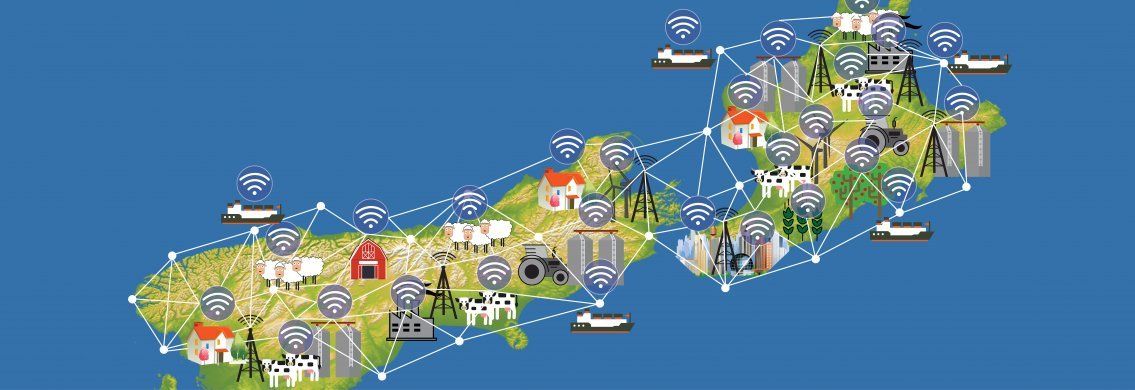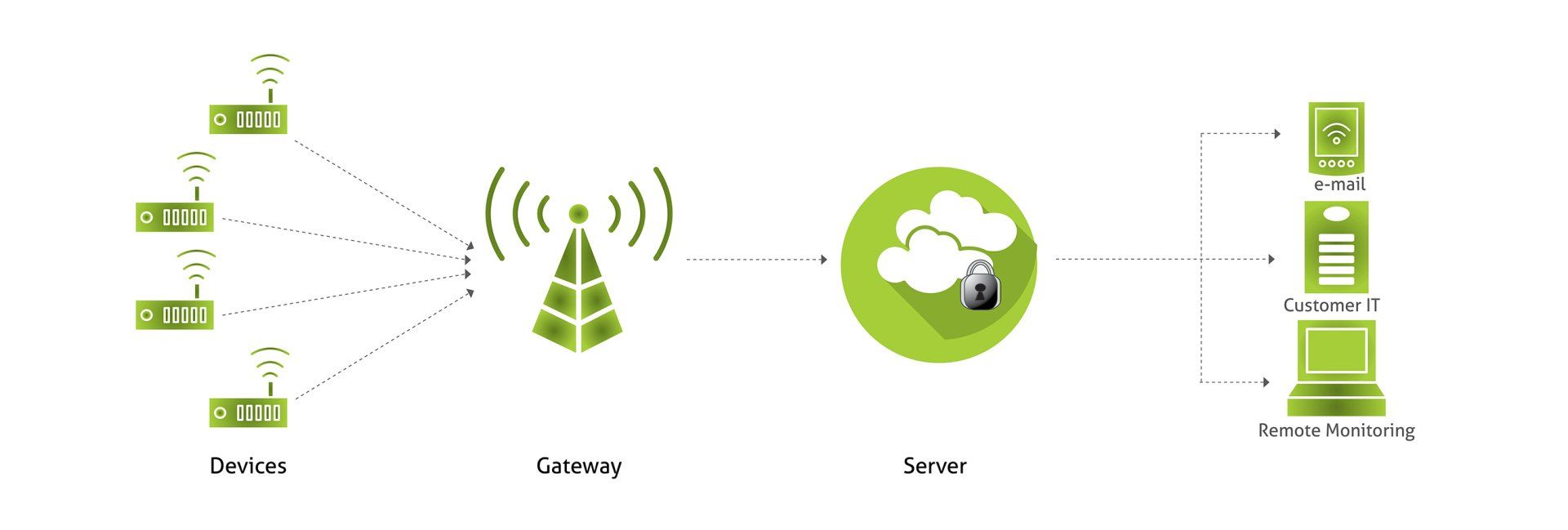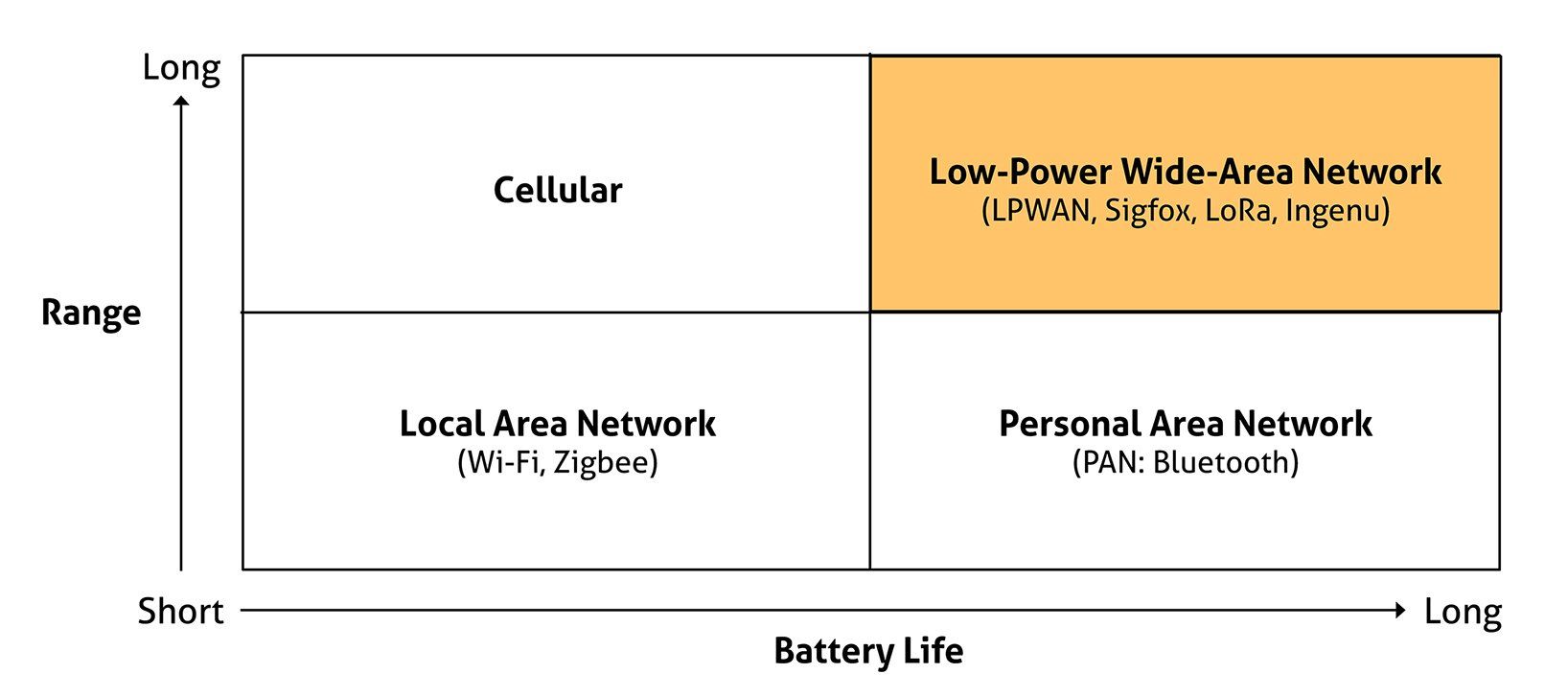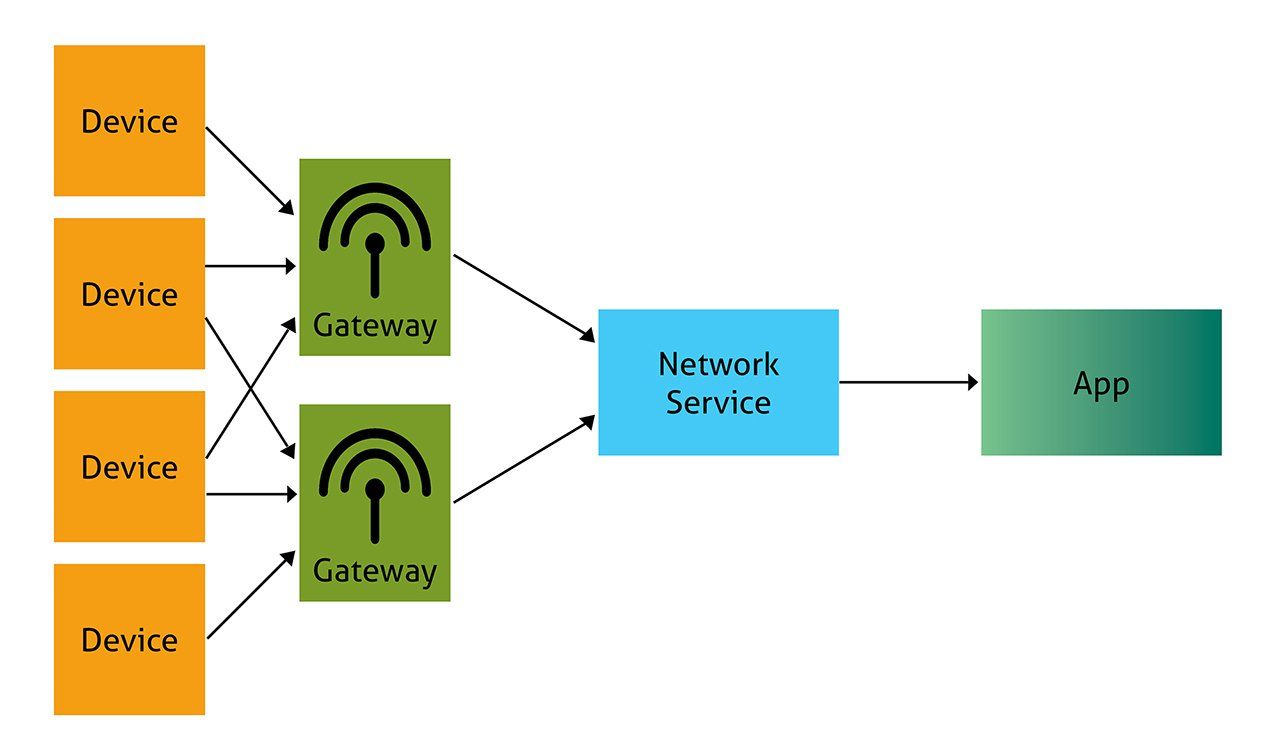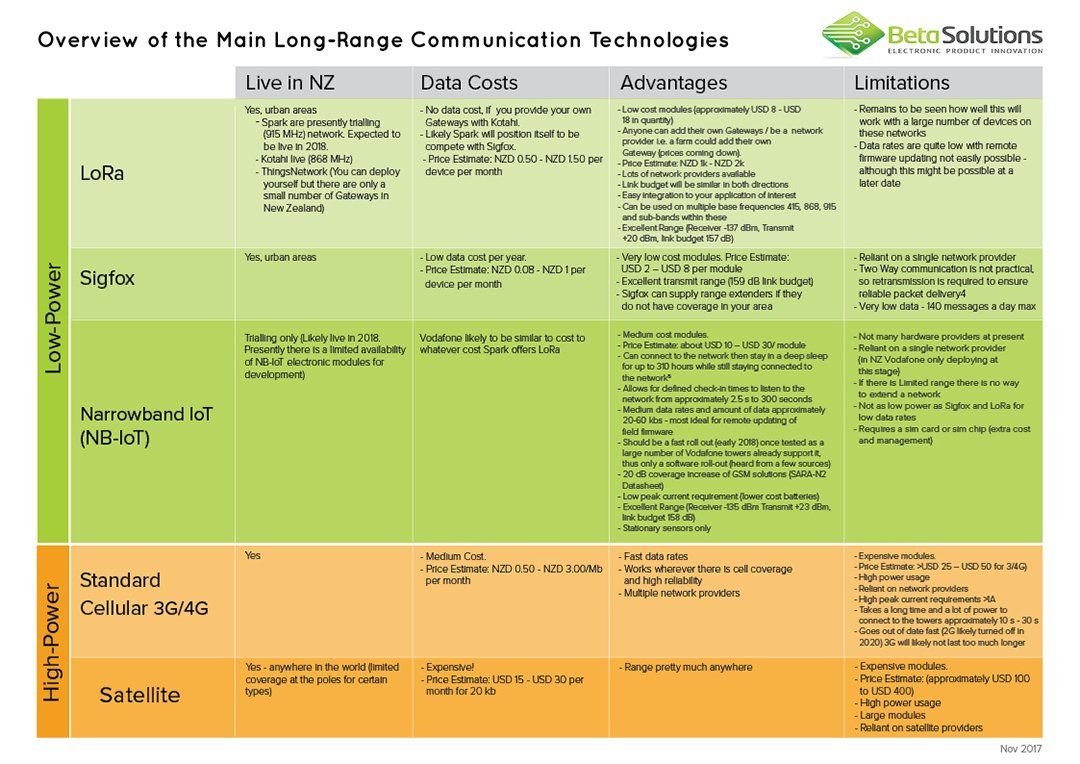Beta Solutions Blog
LPWAN Benefits for IoT Connectivity
Date: November 30, 2017
Due to an increasing demand for an “interconnected world”, by the year 20301 it is predicted that 130,000,000,000 (or if you prefer words: one hundred and thirty billion) devices will be connected to the internet. This is often referred to as the “Internet of Things” or IoT.
Low Power Wide Area Networks (LPWAN) are emerging as a promising and exciting new communications technology which will likely be a key player in helping achieve these tremendously large numbers of connected devices.
The aim of this blog is to provide the reader with a broad overview of LPWAN and to highlight some its significant benefits over existing technologies.
Communications Technologies Defined
Before we look at LPWAN specifically, it would be helpful to provide a basic overview of the general way in which devices connect to the internet.
Simply put - and as readers likely already know - connecting a device to the internet involves sending electronic signals between a Device (“Device”) and The Internet “Server”, in a format that makes sense to both the Device and the Server.
This requires a combination of (i) Electronic Hardware - which physically sends and receives these signals, and (ii) Electronic Software – which controls and orders these signals into an agreed format.
Incidentally, Devices do not connect to the Server directly, but first must connect to a piece of hardware called a “Gateway” which as the name implies, acts as the middleman between the Server and the Device. Multiple Devices can connect to the same Gateway, and there might be multiple Gateways all connecting to the internet.
Figure 1: Device communication/network structure.
So “Communications Technologies” is an umbrella term which refers to both the Hardware and Software which together control the flow of information between end points on a network. Sometimes all that is required to introduce a new communications technology on to the market is a simple software upgrade, while in other cases completely new hardware and software will be required.
Presently, a few different wireless Communications Technologies already exist which can be utilised to connect Devices to the internet, for example:
- Cellular
- Satellite
- Bluetooth
- WiFi
- Zwave
- Zigbee, etc.
LPWAN is a relatively new player to the market but is expected to quickly become a key technology in the IoT sector moving forward.
What is LPWAN?
LPWAN is an abbreviation for “Low Power Wide Area Network”. The term itself implies a generic communications technology as opposed to a fully prescribed communications protocol.
We can break the term down into the following two parts:
- Low-Power - designed to enable devices to operate from small batteries and last 5-10 years
- Wide-Area-Network – designed to communicate over a long range. Approximately 2 km – 20 km +
Although low power technologies already exist (eg: Bluetooth LE) and although long range technologies already exist (eg: Cellular), until now there has not been a technology which is able combine both of these properties.
Figure 22: Sensor range and battery life comparison.
At this stage you might be inclined to think this technology sounds incredibly amazing, but as the saying goes - “you can’t have your cake and eat it too”. Essentially, in order to achieve both Low Power AND long range a trade-off needs to occur, which is that LPWAN technologies are only able to transmit very small amounts of data.
While this makes it decidedly unsuitable for high bandwidth demands such as audio and video, it is still completely adequate for the plethora of applications requiring low data rates. For example, most water tanks do not need to indicate water levels continuously if there has been no level change.
Within the broad LPWAN technology, there are already a number of more specified technologies which include: LoRa, Sigfox, Weightless-N, and a number of others.
What are the Benefits of LPWAN?
LPWAN provides the following benefits:
- Low power usage
The power your Device will consume is highly dependent on how often and how much data is transmitted. However, provided the device does not transmit excessively it is reasonable to expect a battery life of 5-10 years.
NB: Technically, the microprocessor is put into sleep mode when the devices are not operating – drawing very little current. - Low cost / long lasting batteries
Due to the low overall power requirement, these IoT devices can now utilise relatively Low cost batteries – reducing the overall cost of the product.
Technically, in addition to the low overall power requirement, another beneficial property of LPWAN technologies is the low “peak power” requirements. Traditional cellular modems require a very high peak current usage, restricting the battery technologies to more expensive batteries. LPWAN’s relatively low peak power requirements, enables lower cost batteries to be used. - Long distance communications
LPWAN can enable communications at distances of between 3-20 km – which is impressive considering the low power requirements. In reality the actual distance it can communicate is highly contextual. In cities, due to buildings and increased electrical interference, 2-5 km can be expected. In rural environments, with a clear line of sight, 15-30 km is likely achievable. If fact, the Long Range (LoRa) record3 is 702 km, although this was from a weather balloon so we think this is cheating a little. - Low number of Gateways
A positive side-effect of being able to communicate long distances, is that a relatively low number of Gateways are required. This in turn reduces outright infrastructure cost. For example, the entire city of Amsterdam is mostly covered with only around 24 Gateways, which is not bad considering the high density of buildings etc. In rural environments (such as New Zealand farms), it is reasonable to expect 15 km of coverage, and therefore Gateways could be even be shared between farms. - Free radio spectrum
LPWAN operates in the free radio spectrum. This means anyone can transmit and receive on it without requiring a licence or payment for use of this spectrum. This has the advantage of (i) enabling anyone to be a Gateway provider (ii) potentially having zero data costs. - However, one potential downside of using the free spectrum is that a high number of other devices will also operate on the same frequencies – leading to possible “clogging” of the network.
How Does it Work?
If you are interested in a slightly more technical description of how LPWAN works … read on.
How long range is achieved:
Most LPWANs use narrow bandwidth transmissions to achieve long range and some technologies (like LoRa), will also implement some advanced signal processing techniques to further their range.
A basic principle is that the slower you transmit your data the further you can transmit your data.
How slow is LPWAN? Well to put it into perspective, Sigfox can take up to 2 seconds to transmit your tiny 12-byte data packet. A 3G cellular modem would transmit 12 bytes in a fraction of that time. (Data rate of Sigfox is approx 100 bits per second, while 3G cellular can be up to 10,000,000+ bits per second).
How low power is achieved:
Low Power is achieved in LPWAN systems (in part) by specifying that only the device can initiate communication (and not the Server side). The device might communicate 100 times a day or once per day, but it cannot transmit “on demand” from the Server. Therefore, the device does not need to consume considerable electrical power by continuously “listening” to a possible communication from the Server.
The Gateway on the other hand, must always be listening to a possible communication from the Device, but as the Gateways are likely plugged into electrical mains, power consumption of the Gateways is not likely an issue.
This is very different from traditional cellular technologies where the device needs to stay connected to the tower continuously – both to send data and to also listen for more data coming in.
Topology:
A LPWAN network operates with a star topology. There are multiple Gateways that are listening for a device's data. This data is then sent to a network service which then sends a reply back to the Device though the closest Gateway.
The network service also sends the device’s data onto an application Server on the internet.
Figure 3: Standard LPWAN network topology.
What are the Existing Technologies (on the market)?
As previously mentioned, there are several LPWAN technologies already available – including Sigfox, LoRa, NBIoT.
So what technology should you use? Well to that question, at this stage, there is no clear answer as it depends on:
- How much data you are wanting to transmit
- Where your devices are to be located
- Whether you need to add your own network/Gateways in some situations (such as remote farms)
- What your target costs are – including the cost of devices and the cost of data (Some of which remain to be determined)
- The degree of autonomy you want over your network
- Sigfox is more closed
- LoRaWan is more open
Overview of the Main Long-Range Communication Technologies
A brief Overview of LoRa Communication Technologies on offer at the moment, can be downloaded here.
Conclusion
LPWAN is an exciting new technology - and we are expecting a number of infrastructure rollouts in 2018 in NZ (eg: Spark and Vodafone) and world wide.
If you are requiring remote sensors that are compatible with low data rates, then LPWAN would certainly be worth considering.
Beta Solutions has experience in developing products containing various communications technologies, including: LoRaWAN, Sigfox, Cellular, Bluetooth, Wifi, and Satellite communication.
If you are after more information, subscribe to our Blog for updates as the next Blog will give further technical details on LoRaWAN. Alternatively you can get in touch via our contact page or give us a call.
References:
- IoT News, Number of connected IoT devices to hit 125 billion by 2030, says IHS Markit. Retrieved from
https://www.iottechnews.com/news/2017/oct/26/number-connected-iot-devices-125-billion-2030-ihs-markit/
- Sensor range and battery life comparison, retrieved from https://kotahi.net/network/
- Ground breaking world record! LoRaWAN packet received at 702 km (436 miles) distance (08-09-2017). Retrieved from
https://www.thethingsnetwork.org/article/ground-breaking-world-record-lorawan-packet-received-at-702-km-436-miles-distance
- References to blog posts in
https://iot-daily.com/2015/03/13/sigfox-pros-and-cons/
- Let’s talk IoT – NB-IoT/eMTC power saving features: eDRX vs. PSM
https://www.youtube.com/watch?v=1j9lYr95qwU
- Graphic Illustrations by https://www.vecteezy.com/


